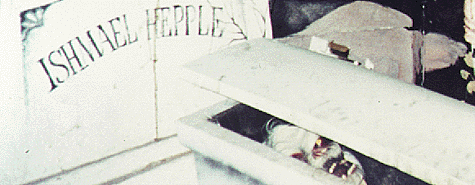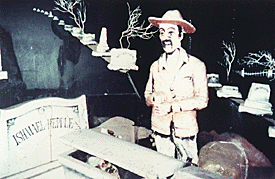
An Age-Old Terror
The spirit of the Dark Ride has been around for centuries
by Brandon Kwiatek
Halloween is the autumnal carnival of the dead, a time for the restless spirits and otherworldly creatures, who frolic and terrorize in a pageant of candles, cardboard skeletons and rubber masks. Though religious reformation has loosened the festival's ties to Catholicism, and secularization has turned it into a capitalist commodity, Halloween perseveres. Each year, it returns the world, for a brief spell, to the whirlwind chaos out of which it was born.
The dark ride is a ride-through Halloween -- summer's sneak preview of the Oct. 31 festivities. But the dark ride, loaded with the trappings of bewitched Protestant Weirdness and the Age of Reason, is also a repository of a thousand years of human history. Skeletons rattle beside a parody of Frankenstein's monster (as filtered through Universal Studios), an on-coming truck with death behind the wheel gives way to an African savage with a bone through the nose. One room leads to an unconnected other, one twist becomes another turn through time and space as dark riders travel an erratic line from mad science lab to jungle wilderness to ghost highway over a span of three minutes.

Despite the random array of elements and icons, we understand their message perfectly. All signs point to scariness and, inevitably, foolishness. And, as we peer back into the shadowy past, we find that people have been taking dark rides of one sort or another for a very long time. Summoning devils, conjuring ghosts and animating skeletons for frightening entertainment is a cross-cultural commonality.
The knotted-up roots of the modern, Western imagination of death, the devil and hell can be found in medieval Europe. In that time, vernacular sermons and penitential literature, apocalyptic books and visionary narratives, illustrations and paintings, religious legend and popular drama influenced and refined one another. The constant flow of reciprocal creativity nourished Christian beliefs with symbols of heaven and hell, good and evil.
Three main Biblical references (Revelation 20:1; Matthew 16:18; and Job 41:14) describe hell as, respectively, a pit, a gate and a mouth. These metaphors were scanty and required generations of literary and oral tradition to embellish them with details borrowed from pre-Christian mythologies. Out of the Mesopotamians' Gilgamesh and Homer's Odyssey, both epic travels including a descent to the land of the dead, early Christians constructed the landscape of the underworld and populated it with the terrors of the pagan mind.
The heroic journey to the underworld is so old and so pervasive that it is called the "descent motif" of human culture. In medieval Europe, staged performances of Christ's Harrowing of hell were enormously popular. In the 14th through 16th centuries, the most-performed mystery and miracle plays were those which required the portrayal of Satan, Lucifer and a miscellany of devils. Curiously, they were often the most developed characters in the plays, and their personalities ranged from malevolently cunning to stupidly comic. In the several plays which involved hell as a scenic location, the hellmouth became the central and most elaborate feature of the stage. It was where devils ran out hooting, farting, clowning, and exploding firecrackers before they and their captured sinners were swallowed back into the infernal belly of eternal death and destruction.
Give me that old time religion
Ludicrous devils were good for guffaws, but they were even better for defeating symbolically the real hell that they represented. Literally the most explosive comic relief in the religious cycles, a variety of devils used pratfalls, slapstick exchanges, ludicrous parodies with inverted values and rituals to elicit laughter from their audience. The tendency toward the comic devil figure began in the theater as early as the 12th century under the influence of the folk performances of mimes, jugglers and maskers. The comic flavor was born in Carnival, Christian excuses for the old time paganism in the weeks prior to Lent.
Subsequently, the cycles as a whole became expressions of Carnival -- celebrations of food, sex and violence officially sanctioned by the Church but simultaneously and symbolically antagonistic to it. It is the devil who best characterizes this intimate bond between fertility and decay, and laughter and horror. Like his relatives the fool and clown, who rise in mock resurrection after being beaten, the manhandled medieval stage devil emerges from the mouth of death to recite a humorous monologue. Today, the immortal or clever devil figure wears the guise of Wile E. Coyote, wise-cracking Freddy Krueger, and the cackling, punning Cryptkeeper.

Like anything else seen too often and for too long, the gaping jaws of the hellmouth gradually lost their power as a symbol for moral admonishment. By the 16th century the vernacular hellmouth was an inadequate representation of the fire and brimstone that burned below. Popular fondness for the symbol alone kept it alive through artistic reinterpretations. Eventually the subject of year-round parody, the hellmouth soon enclosed fireplaces, doorways, and windows as mere tokens of the ancient and superstitious mind.
The intersection of strict Catholicism, reformations and humanism during this period marked the birth of the secular -- the examination of the world and self without religious interpretation. Subsequently, and especially during the next centuries of reformation and counter-reformation, the grand effects of the medieval imagination became a treasure to plunder. Later still, the Age of Reason cut the fantasy land and costumed characters from that old, enchanted and grotesque world and pasted them into a collage for satire, thrilling amusement and nostalgia.
Dancing around death
Numerous though they are, the dark ride's legion of devils are outnumbered by its skeletons. Suffice it to say that, prior to secularization, human bones weren't very chilling. Not yet grim emblems of mortality, skulls and bones were quite familiar. But with the separation between sacred and profane worlds came the separation between the world of the living and that of the dead.
Prior to this separation, well-pronounced by the 18th century, the European attitude toward their dead was casual and familiar. The dead literally surrounded churchgoers, both inside and out, in a religious community of living and dead: the important dead lay inside the church, buried under flagstones, pillars, porches, and in attics; lesser individuals were buried in anonymous graves in yards directly beside the church; thousands lay buried in common ditches, 15 to 30 feet deep. In the churchyard, bones lay just under a bare covering of ground, mixed with the stones, pebbles and grass.
From the 14th to the 18th centuries, cemeteries were not only public places but centers of communal life. Markets, fairs and pilgrimages animated them with crowds who found nothing incongruous about celebrating amidst corpses, because the dead themselves weren't scary. Strangely enough, walled, unpublic burial areas were created to protect the dead from the living. Private graveyards responded to the lowliest orders of social interaction occurring in the marketplace: prostitution and theft.
The plagues which swept through Europe, decimating populations, profoundly altered the European attitude toward death. Beginning in the 14th century, and on tombs especially, new and horrendous images of the dead in various states of corruption were the norm. Graphically detailed, the designs resembled the images of the Danse Macabre and reminded viewers of the temporal state of the body and immortal state of the soul. The skeleton is a resonant image of mortality that persists today, even in the funny bowels of the dark ride.
Good for a laugh and a thrill
The hells and netherworlds of the dark ride are laughable parodies of our worst imaginations of afterlife or oblivion. Constructed of gaudy paper maché and glass fibers layered over arthritic armatures and muscled by erratic shocks of electricity and compressed air, hell's demons and life's grim reapers are reduced to powerless cartoons that evoke not dread but laughter. The journey permits its riders to see the unknown pop out of the darkness, skirt triumphantly around its ridiculously inadequate spectacles, and to defeat death, for the moment at least, with a gasp and a grin.
The dark ride's combinations of familiar images is a mediation between life and death in which the living can control the terror of dying. It is precisely this need to control the ultimate fact, sanitizing and suppressing it wherever possible, that Walter Kendrick describes in his excellent book, The Thrill of Fear (1991), linking it to the past 250 years of horror as entertainment. The moody decorations of the mouldy, disease-ridden "Dark Ages" enhanced the horrific in literature poetry, and architecture. Such Gothic stylizations turned the past into something haunted and fearsome -- something to put a tingling thrill into scientific but sterile lives.
Theatrical horror has never been pure but has always been diluted with humor. From its cultural inception to the Ghost Illusions and Magic Lantern Shows of the 19th century, which made light of ghosts and goblins, and from Hollywood's haunted house comedies of the 1930s and '40s to the Toxic Avenger and the Evil Dead which treat zombie gore as slapstick, horror in the media existed, and still exists, to be degraded with laughter. If humor is not contained within the source itself, then it invades from the outside à la Mystery Science Theater 3000 in a barrage of viewer insults directed at the film's technical ineptness, poorly crafted plot or bad acting.
After all, Campiness is built into the genre, and all the pyrotechnics and computer-generated images can't make a film transcend its nature. In the vernacular, "awful" films do not inspire awe but are simply poorly executed; "terrible" films do not instill terror; they're just bad. Traditional dark rides, too, are "awful" and "terrible" in these common senses: they exist to be insulted for their obvious flaws.
The dark ride disorients with not only its tightly winding track but also its pandemonic assemblage of "strange adventures' with sights and sounds. The dark ride is also light -- absurd and laughable imagery blunts the edges of horror, and its best gags turn on a reinvigorating shock. Eyes straining in the dark, heart throbbing with anticipation, we rarely feel so alive as when we are in the dark ride. As we scoot along the narrow track, we travel the crooked line between some of the big opposites -- life and death, comedy and horror -- and erase the divisions between them.
This is the second in a three-part series on the history and cultural significance of the dark ride. The first article dealt with the current status of dark rides, and investigated their contribution to American culture. The third article will examine the dark ride's future in the new-fangled "theme experiences," ride films, and virtual reality.
Brandon Kwiatek is a card-carrying member of the National Amusement Park Historical Association. He has a master of arts degree in folklore from Western Kentucky University, and his recently completed thesis The Dark Ride is the definitive study of the subject.






